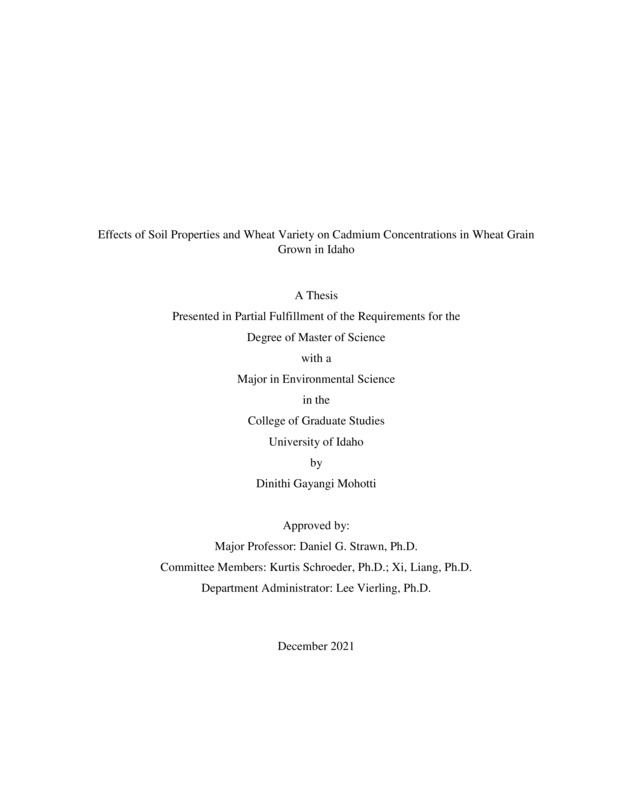Effects of Soil Properties and Wheat Variety on Cadmium Concentrations in Wheat Grain Grown in Idaho
Mohotti, Dinithi Gayangi. (2021-12). Effects of Soil Properties and Wheat Variety on Cadmium Concentrations in Wheat Grain Grown in Idaho. Theses and Dissertations Collection, University of Idaho Library Digital Collections. https://www.lib.uidaho.edu/digital/etd/items/mohotti_idaho_0089n_12203.html
- Title:
- Effects of Soil Properties and Wheat Variety on Cadmium Concentrations in Wheat Grain Grown in Idaho
- Author:
- Mohotti, Dinithi Gayangi
- ORCID:
- https://orcid.org/0000-0003-2222-0197
- Date:
- 2021-12
- Embargo Remove Date:
- 2023-09-01
- Keywords:
- Cadmium Idaho Soil properties Variety Wheat grain
- Program:
- Environmental Science
- Subject Category:
- Environmental science; Soil sciences; Plant sciences
- Abstract:
-
Cadmium accumulation in wheat (Triticum aestivum L.) is a major pathway for human exposure causing risks to human health. The availability of Cd for uptake for wheat grains varies significantly with plant and soil properties. Idaho is one of the major wheat-growing areas in the United States, and it is important to investigate the regions and varieties that produce ultra-low Cd wheat grain to minimize health risk and improve the quality of food products. To discover the relationship between Cd uptake by wheat and soil properties and variety, grain and soil samples were collected from both southern and northern Idaho fields and metal content of grain and soils were measured, as well as soil properties. The main soil properties that affect Cd uptake by wheat were determined using three different regression models: Stepwise regression, Random Forest, and Partial Least Square. Means from different wheat varieties grown in different regions were evaluated to determine differences.Almost all the wheat varieties grown in Idaho are safe for adult consumption, but most of them exceed the maximum allowable limit of Cd in infant food which is 0.04 mg/kg (EFSA, 2014). Among 65 different wheat varieties, UI Petit, a soft white spring wheat cultivar, had the highest Cd concentration, while UI Sparrow, soft white winter wheat, had the lowest Cd concentration. The regression models revealed that DTPA Cd, Olsen P, total Cd, DTPA Zn, total Zn, total P, total N, NO3—N, and organic carbon were significant soil measurements related to wheat grain Cd concentrations. Among them, DTPA Cd and Olsen P were identified as the most significant predictors for wheat grain Cd concentration in Idaho. Results from this research suggest that Cd bioavailability is one of the best predictors for Cd concentration in wheat grain, and management of phosphorous fertilization application is required to achieve low Cd concentrations. The modeling approach was shown to be accurate when applied to other varieties and locations in Idaho.
- Description:
- masters, M.S., Environmental Science -- University of Idaho - College of Graduate Studies, 2021-12
- Major Professor:
- Strawn, Daniel G
- Committee:
- Liang, Xi; Schroeder, Kurtis; Vierling, Lee
- Defense Date:
- 2021-12
- Identifier:
- Mohotti_idaho_0089N_12203
- Type:
- Text
- Format Original:
- Format:
- application/pdf
- Rights:
- In Copyright - Educational Use Permitted. For more information, please contact University of Idaho Library Special Collections and Archives Department at libspec@uidaho.edu.
- Standardized Rights:
- http://rightsstatements.org/vocab/InC-EDU/1.0/

